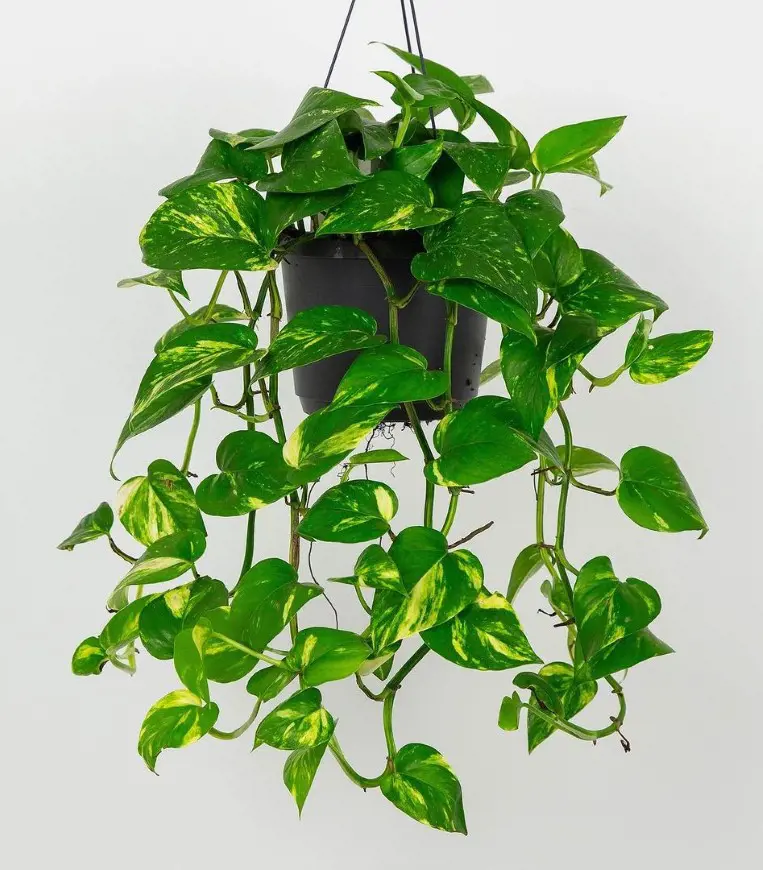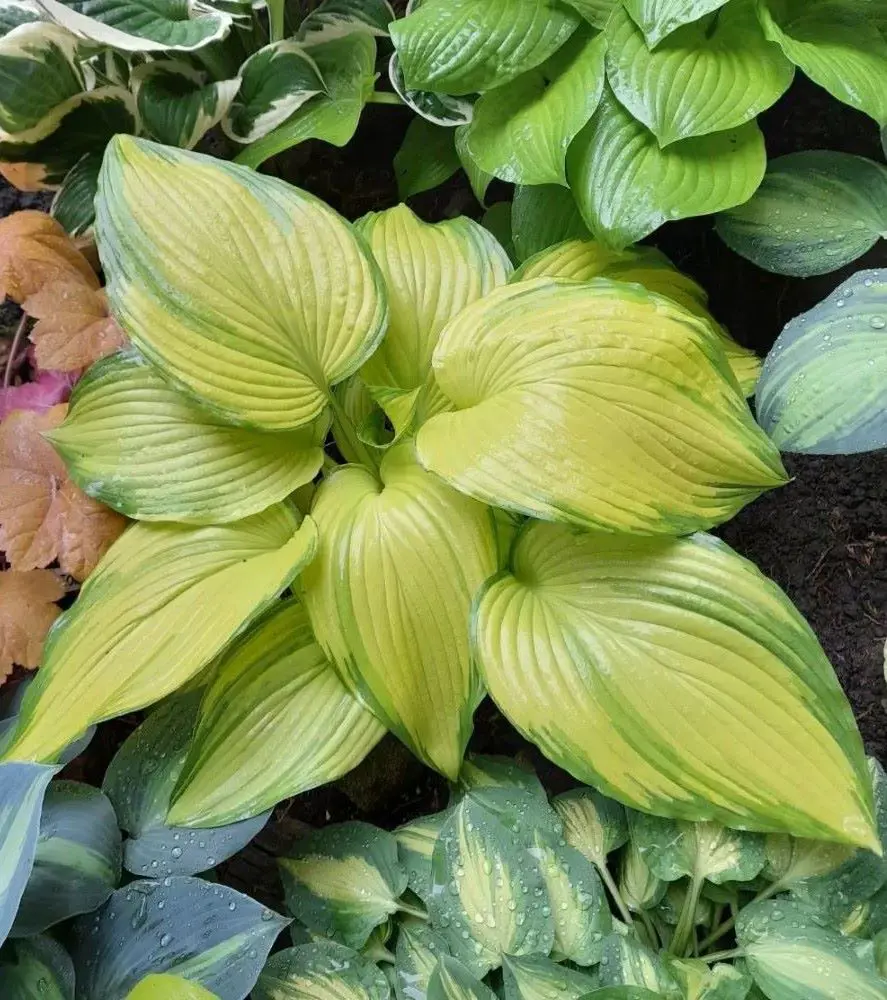Pothos Plant Care And Growing Guide

This post may contain affiliate links. If you make a purchase through links on our site, we may earn a commission.
Adding a Pothos plant (Devil’s Ivy) to your home benefits the environment and aesthetic of your personal space. It's easy to maintain and is loved for it's ability to enhance indoor air quality by removing toxins like formaldehyde, benzene, and carbon monoxide. It has attractive foliage, virtual indestructibility, and low maintenance requirements. Due to these various factors, pothos plants are popular in temperate regions.
It's critical to understand pothos plant maintenance before bringing pothos indoors. Here's how to care for and maintain pothos plants.
Pothos Plant Overview
| Scientific Name | Epipremnum aureum |
| Common Names | Pothos, Golden Pothos, Devil's Vine, Devil's Ivy |
| Family | Araceae |
| Type | Vine |
| Size | 20–40 Ft. (Height), 3–6 Ft. (Width) |
| Sun Exposure | Full Sun, Partial Shade |
| Soil Type | Moist, Well-drained |
| Soil pH | Neutral To Slightly Acidic |
| Bloom Time | Rarely Flowers |
| Colors | Golden, Yellow, Purple |
| Origin | Asia |
| Toxicity | Toxic To Dogs And Cats |
What Is A Pothos?

Pothos is a common and well-liked houseplant. It has thick, big, heart-shaped leaves on these plants which make them so well-liked. It is a Southeast Asian tropical vine. A pothos plant will provide your house or place for work an attractive touch. It is easy to maintain and care for pothos.
Pothos spread very quickly. In a month, its length increases by 12 to 18 inches. Due to this fact, pothos can be introduced in any type of soil and water quality as it will thrive in the environment.
The plant has a remarkable benefit, it enhances indoor quality by removing toxins like benzene, carbon monoxide, and formaldehyde from the air.
Note: In nature, pothos are toxic. It is harmful to both people and animals.
Pothos Plant Care

Pothos do not require more care and maintenance. The only thing you need to do is water frequently in the time difference of 7-8 hours. The plant should be in new pot soil when the old soil degrades. Apart from this, trim a long runner to keep the plant dense. Clean the dust from the foliage time and again.
Pothos plants live for 5 to 10 years with proper care, the plant can live much longer.
Light
Pothos should be avoided from direct sunlight. It can be planted in partial sun or low-light areas. Direct sunlight harms the leaves, leading to scorching which results in the development of brown edges which compromises their ability to photosynthesize and grow. Likewise, if the plant doesn’t get proper light, the plant can lose vibrant color and stretch out. Its vibrant look disappears as it takes on an extended, less vibrant form.
Soil
Pothos plants can easily grow in well-draining soil rich in nutrients. For proper growth, the mixture of peat moss, perlite, compost, and vermiculite should be mixed in a ratio of 1:1:1 in soil. Also, the soil should contain proper moisture to keep roots hydrated. By maintaining all these factors you can thrive pothos indoors beautifully
Water

The soil should be moist so it requires water frequently depending on different factors like humidity, light, and temperature. Keep water every one or two weeks. It requires more water during the growing time and less water in winter. Water the pot until water starts to seep back up from the bottom, which helps to adjust the soil properly on the root.
Root rot also kills plants, so don't keep them in standing water. Adjust your watering frequency according to the size of the pot, the type of soil, and the amount of light.
Temperature and Humidity
Pothos plants grow in high humidity. The plant required a humidity range between the range of 65°F to 75°F and a temperature above 50°F. You can keep the plant near the bathroom, near other tropical houseplants to increase the humidity. Using a humidifier in the room as well as putting pots on trays filled with pebbles and stones increases the humidity in plants.
Fertilizer
They are not heavy feeders but for proper growth, they require a balanced fertilizer once a month in summer and spring. Avoid fertilizing in winter because growths are very slow.
Use water-soluble fertilizer for ideal fertilizer. Apply every two to three weeks using a watering can after diluting to half strength as directed by the manufacturer.
Support

They are climbers, which means they require support for proper growth. Give them support by keeping a moss pole or a trellis nearby. For extra moisture, consider a moss-covered pole, or build a charming climbing area with a trellis. You can hang in the basket if you have little space.
Pruning
Pruning is very important to maintain the health and proper growth of the plant. Spring and summer are the best time to prune as the plant grows continuously. It allows for new growth and quick recovery and removes damaged and yellow leaves.
Use a sharp and clean scissor to prune to avoid the risk of diseases. Try not to cut off more than one-third of a plant. Inspect the plant's general shape after pruning, and modify it again if required.
Repotting
Repotting the pothos plants plays a vital role in maintaining their health and proper growth as their roots grow quickly in the container. Here are some steps to repot the plant properly.
1. Choose a large pot with a good drainage hole at the bottom filled with fresh soil.
2. Loose the soil from the old pot, be sure to water your pothos a few hours before repotting.
3. Slowly remove the plants from the old pot carefully without damaging any roots.
4. Trim the rot or overcrowding roots with sharp scissors.
5. Keep the pothos plant in a fresh pot at the center and fill it around with soil.
6. Provide proper water to new potted pothos, allowing excess water to drain out from the bottom of the pot which helps to settle the soil around the roots.
7. After completing all these steps, maintain the pothos plant’s proper health by maintaining proper light, humidity, and temperature.
By following all these steps, you can grow healthy pothos which grow in new surroundings.
Propagating Pothos Plant

The best time to propagate the pothos plant is summer. The time allows better growth and rooting of the plants. Propagating should be performed for almost 1-2 years, which prevents overcrowding and proper growth.
We can propagate pothos by cutting the stem. Cut around 6 inches of healthy steam from growing pothos by removing the leaf at the end. Keep the cutting stem in the glass filled with water in bright, indirect sunlight for several days. When the proper root is developed, pot the rooted cutting in the container which contains well-draining soil.
Water lightly at the beginning and gradually increase watering as the new plants develop. By following these tips, you can successfully propagate the new and healthy pothos plant.
Pothos Plant Types
Pothos plants are available in different types. Each type has different appearances and characteristics. Here are some popular Pothos:

- Golden pothos: These types of pothos have heart-shaped yellow and green variegation. It prefers medium to low light conditions. It is easy to care for and is best among the air-purifying plants. Due to these benefits, Golden Pothos is a favorite choice for indoor areas.
- Marble Queen: Pothos plants with a beautiful variegated pattern of green and white are marble queens. To maintain a unique coloring than other Pothos it requires extra light. It is a good choice for hanging from shelves or hanging baskets as it grows well in bright, indirect light.
- Neon: These types of pothos require less light and contain fluorescent green leaves. Neon pothos glow or brighten up a dark area of the room.
- Silver Satin: The leaves of the silver satin pothos are gray-green with silver splotches. It can adjust in low light and drought conditions.
- Pearls and Jade: This variety has small and thin leaves which contain different variegation patterns. Its leaves are white and green. It is one of the best choices for a decor room or office space. It adds a touch of lush greenery to the space by adding natural light.
- Manjula Pothos: Manjula Pothos are extremely colorful pothos. Large, heart-shaped leaves with cream, white, and green variations are its features. The variation can thrive in bright, indirect light.
These types vary not only in appearance but also in care requirements and development patterns, making them appropriate for diverse indoor gardening tastes and aesthetics.
Challenges And Issues With Pothos Plant

Pothos is a generally healthy species, yet it is still at risk from certain conditions. If the issues are not appropriately resolved, the plant might suffer significant harm.
Although pothos do not attract any pets, they can attract different insects like spider mites, whiteflies, scale, etc. To remove such insects use neem oil or intertidal soap or use soft clean clothes to remove pets. Here are some common problems that occur in pothos plants.
Yellow Leaves
You don’t need to worry if there are yellow leaves. Overwatering or underwatering may turn leaves yellow. Likewise, Sometimes direct exposure to sunlight and nutrient deficiencies leaves may turn yellow.
Solution: There are various ways to fix yellow pothos leaves. Some of the simple steps you can perform are avoiding overwatering, maintaining sufficient drainage, placing the plant in direct sunshine, and providing appropriate fertilizer to fix nutrient deficiencies.
Browning Leaves
Brown leaves occur due to overwater or little sunlight. Leaves that are dry and crunchy indicate underwater.
Solution: Maintain proper water level, increase the humidity of surroundings, and provide partial sunlight.
Drooping
Drooping is a sign of stress. Due to lack of water or overwater the root of the plant may rot. Which causes pothos leaves to droop. It is also a symptom of the plant being affected by diseases.
Solution: provide proper water and maintain soil moisture. Trim the rotted roots and repot the pothos in fresh fertilized soil.
Inadequate Light
Pothos plants need bright and indirect light from the sun. Normally, it required a 10,000 to 20,000 lux range of sunlight. Exposing directly to the sunlight leads to scorching of the leaves while insufficient light causes spare leaves and leggy growth of the plant.
Solution: Place the plant in the perfect location (bright location with indirect sunlight). Do not overexpose in direct sunlight which may result in scorching the leaves.
Note: Take some cuttings from healthy growth if your pothos aren't doing well and use them to grow new plants. For more fuller growth, you can also report your plant and add rooted pothos cuttings.
Recent posts
Plant Care
Plant Care
How To Take Care Of An Orchid Plant? 11 Tips And Tricks
If you love gorgeous orchids but are worried they're too high-maintenance, don't worry. This guide is like a cheat sheet for orchid newbies. Forget fancy words and confusing schedules — we're talking about how to take care of an orchid pla...
Plant Care
How To Grow and Care For Peace Lily Plant
The Peace Lily is an indoor plant that is most valued for its beautiful and shiny green leaves as well as the white blooms. Hard and tolerant, it’s naturally a low-maintenance addition to your plant collection. If you are confused, let us tell ...
Plant Care
Snake Plant Care and Growing Guide
Snake plants require low maintenance, and low light and are almost impossible to kill, making them a perfect plant for beginners and seasoned gardeners. In this guide, we will explore essential care tips and optimal growing conditions for snake plant...
Plant Care
How To Plant, Grow and Care Majesty Palm
The majestic palm, scientifically known as Ravenea rivularis, makes for a stunning indoor tree with its lush and grand fronds. Originating from Madagascar's river banks, this resilient houseplant is cherished not only for its beauty but also for its ...
Plant Care
How To Grow And Care For A Hosta Plant
Hosta plants are widespread perennials, often grown for their beautiful and diverse foliage. They are extremely easy to care for and can thrive in various conditions, particularly shade or semi-shade. These hardy plants can last for many years and re...
Plant Care
Reasons Why Tomato Leaves Are Turning Yellow
If your tomato leaves are turning yellow, it's a cause for concern when you've put effort into growing them for that homegrown, delicious taste. The yellowing could result from various issues affecting your kitchen garden aspirations. Our guide simpl...







